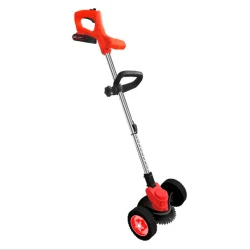Considerations for Choosing a Weeder
2024-05-31
A weeder is a handheld gardening tool designed to remove weeds from the soil, helping gardeners maintain healthy and weed-free garden beds, lawns, and landscapes. Here's an overview of weeders, including their features, types, benefits, and considerations for choosing the right one:
Features of Weeders
1. Handle: Weeders typically feature a long handle for comfortable gripping and leverage during use. Handles may be made of wood, metal, or plastic, depending on the model.
2. Blade or Tines: The business end of a weeder consists of a blade, tines, or claw-like attachments designed to penetrate the soil and extract weeds from the root. The blade or tines may have different shapes and configurations depending on the type of weeder.
3. Shaft: Weeders have a shaft or stem that connects the handle to the blade or tines. The shaft may be straight or angled for ease of use and access to tight spaces.
4. Materials: Weeders are typically made of durable materials such as stainless steel, carbon steel, or aluminum to withstand the rigors of garden work and resist rust and corrosion.
Types of Weeders
1. Handheld Weeder: Handheld weeders are compact tools with a short handle and a pointed blade or forked tip for precise weeding in small areas or between plants.
2. Long-Handled Weeder: Long-handled weeders have an extended handle for reaching weeds in large garden beds or while standing, reducing the need for bending or kneeling.
3. Stand-Up Weeder: Stand-up weeders feature a long handle and a foot pedal or lever mechanism that allows users to remove weeds while standing, minimizing strain on the back and knees.
4. Hoe or Cultivator: Hoes and cultivators are versatile tools that can be used for both weeding and cultivating soil. They feature a blade or tines attached to a handle and are effective for breaking up soil and removing weeds.
Benefits of Weeders
1. Precision: Weeders allow for precise weed removal, targeting individual weeds while minimizing disturbance to surrounding plants.
2. Efficiency: Weeders help gardeners save time and effort by quickly removing weeds from garden beds, lawns, and other outdoor areas.
3. Root Removal: Many weeders are designed to remove weeds from the root, preventing regrowth and reducing the need for chemical herbicides.
4. Ergonomics: Long-handled and stand-up weeders promote ergonomic gardening practices by reducing strain on the back, knees, and hands.
5. Versatility: Some weeders can also be used for cultivating soil, aerating compost piles, or digging planting holes, making them versatile tools for garden maintenance.
Considerations for Choosing a Weeder
1. Type of Weeds: Consider the type and size of weeds you need to remove, as well as the terrain and soil conditions in your garden, when choosing a weeder.
2. Handle Length: Choose a handle length that is comfortable for your height and allows for easy maneuverability in your garden space.
3. Blade or Tine Design: Look for a weeder with a blade or tine design that suits your preferred weeding technique and the types of weeds you encounter.
4. Material Quality: Select a weeder made of durable materials that can withstand repeated use and exposure to outdoor conditions.
5. Ease of Use: Consider the ease of use and maintenance of the weeder, including features such as ergonomic handles, rust-resistant coatings, and replaceable parts.
6. Budget: Weeders are available at various price points, so consider your budget and invest in a quality tool that will provide reliable performance over time.
Conclusion
Weeders are indispensable tools for gardeners seeking to maintain weed-free and healthy outdoor spaces. By choosing the right type of weeder based on your gardening needs, preferences, and budget, you can effectively remove weeds and promote the growth of desired plants in your garden beds, lawns, and landscapes. Whether you prefer a handheld, long-handled, or stand-up weeder, these tools offer precision, efficiency, and versatility for weed removal and garden maintenance tasks.



